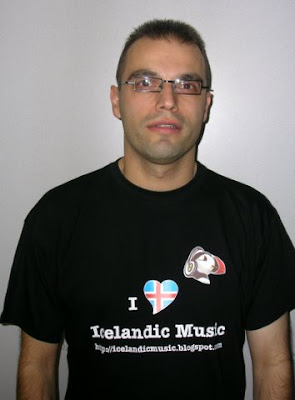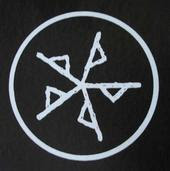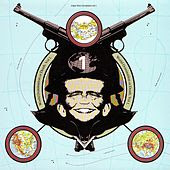 Last Call: Sirkus is Closing
Last Call: Sirkus is Closingby
Steinunn Jakobsdóttir
Published in
Grapevine: Issue 18, December 07, 2007
http://www.grapevine.is/“Of course I’ll miss this place. I mean, where else can you find such a good vibe on a Sunday evening?” says the bartender at
Sirkus and hands over a beer. It’s around midnight and a few people are dancing to Michael Jackson’s ‘Beat It’. Sparkling leftovers of last night’s decorations still hang from the ceiling. It was a Super Hero costume party, a crazy night I was told. The staff and a couple of regulars sit around the bar and chat about the weekend and the fact that in two months, the party will at last be over. In February, the tiny tavern will have to close its doors to make room for underground parking lots, hotel rooms and fashion shops.
Sirkus, this notorious little bar on
Klapparstígur 30, bred a peculiar and energetic culture years ago and the many loyal beer-drinkers see the shutdown as the end of an era. The staff, as well as the regulars, talk about their small Sirkus community as a big friendly family where Sigga, the owner, is like a mum. It’s no overstatement that few places in the world have established as big and loyal a customer base as Sirkus. The affection among the customers can perhaps best be seen by all the postcards and souvenirs from faraway countries that decorate the bar today.
Frequented by the creative crowd, Sirkus is known as a shelter for artists, fashion designers, writers, filmmakers, art-lovers and music-lovers. The city’s many barhoppers break free to the music blasting from the speakers every weekend, or on a Monday night for that matter, and dance for hours on the sticky floor. With a capacity to accommodate around 100 people, this hut with palm trees painted on the outside walls, is a place where world-famous DJs come to spin their records and partypeople climb the walls and queue for up to an hour outside to be part of the lunacy that goes on inside.
Sirkus’s reputation has travelled the world. With
Björk DJ-ing from time to time, renowned and up-and-coming bands throwing awe-inspiring concerts and movie-stars dropping by for a night on the town, the bar is featured in music videos, magazines and travel books. Every year, it attracts a growing number of curious tourists who go on sight-seeing trips just to take a look.
“Sirkus is a ‘night-care’ for grown-up teenagers” explains
Sigga, the owner, and laughs. Sigga, usually called Sigga Boston, is the woman in charge. She’s seen it all. Good times and bad times. In
2006, she opened a new bar,
Boston, with her longtime friend Hildur Zoega and can today frequently be seen running between the two taverns with her dog Hekla tagging along.
“I can’t be too bummed about it. We always knew this would soon be over but somehow Sirkus always stays open for another year. I’ve said my goodbyes plenty of times,” one regular said when asked how he feels about Sirkus finally closing its doors. “Maybe it’s just time to move on, but I’ll leave Sirkus with countless great memories” he adds.
One of the most remarkable things about Sirkus is the fact that it is even still open. The end has been around the corner more than 20 years, long before Sirkus became Sirkus or today’s clientele even started drinking. But like a cat with nine lives, it has managed to extend its life longer than anyone could ever dream of.
Creative Hotspot
“No one is grieving the house per se but rather everything that has happened inside the house,” says artist
Gabríela Friðriksdóttir, a long-time Sirkus family member. She continues: “Just imagine Unuhús (which was a popular hangout among young artists and writers in the beginning of the 20th century) and what a significant role that building played in Reykjavík’s culture. Sirkus is like the
Unuhús of our time. Sirkus isn’t a house but plenty of souls that gather to create this unique atmosphere. Sigga plays a leading role in this. She has everything needed to run a place where you can feel at home and get to be just the way you want to be. She’s like a mother, a shrink and a friend.”
The valuables that belong to Sirkus have little to do with concrete or corrugated iron. As a building, Sirkus is almost worthless. All the dancing and drinking have taken its toll and today, it could hardly be described as majestic. Some might even call it a dump. But although its walls, covered with music posters and artwork, might collapse any minute, they’ve witnessed an essential part in the city’s culture, as for years, Sirkus has been a hotbead of everything related to any grassroots genre in art, music, fashion and filmmaking. Here, local bands have taken their first steps and new talents have been discovered. In between touring around the world, groups such as
GusGus,
Sigur Rós,
múm have gone to Sirkus to relax. Brian Jonestown Massacre’s Anton Newcomb has basically moved in. Friendships that lead to collaborative projects have evolved over a few drinks and numerous artists and designers come by regularly to seek inspiration for new pieces. It’s hard to put a price on that.
“In my view, the bar represents this crossover between art and music. To find my inspiration, I go to Sirkus for example always. You can be just the way you want to, you can easily get to know whomever you choose without any barriers or uncomfortable formal introductions. All the crew I’ve worked with I met in this building. That’s why we always give a special credit to Sigga Boston, Mother Superior, when we exhibit around the world,” says Gabríela.
A Legendary Hangout
The small hut that today houses the notorious bar has a long history. In the early 19th century it housed the grocery Vaðnes but for the past two decades, it’s been a centre for socializing and drinking. In 1990,
N1 bar, popular among musicians and music-lovers, opened its doors, pub
Grand Rokk moved in for a while and in the late 1990s, Reykjavík’s very first French wine bar served fine wines and snacks to downtowners. That bar was called Sirkus and has kept its name since.
Sigga knows more about the house and its past and present customers than most people and she’s no rookie when it comes to running a successful bar. She has followed the Icelandic art and music scene for decades and in the 80s while studying in Boston, ran her own club inside an old diner called Premia. Since 1990, the building on Klapparstígur has been her second home and she has waited for years for the moment it would all come to an end.
“I started working there in
1990, but my first job after I moved back home was to design N1 bar. At that time, the decision had already been made to tear down the house,” she says. Sigga goes on to explain that in the 90s, N1 bar was the hangout of the Icelandic supergroup
the Sugarcubes and their friends. “Me and
Einar Örn even owned the bar for three months and the Sugarcubes got their mail delivered there, it was that much of a home.
Björk was a DJ,
Magga Örnólfs and
Sigtryggur Baldursson worked at the bar and
Einar Örn managed the door,” she adds.
On December 20,
2000, Sigga reclaimed Sirkus: “Stephanie, who ran the French wine bar, wanted to sell the business. Some business guys had offered her 20 million ISK for the place but she didn’t feel good about it. One day, when we sat down for a drink she asked me: “Sigga, don’t you feel like this place is like your child? Isn’t it sort of like we share this child together? I won’t sell it to anyone but you.” And I bought Sirkus for 4 million ISK!”
Intimate Melodies and Rowdy Rock Shows
Ever since
the Sugarcubes called the place home almost two decades ago, the importance of Sirkus for the Icelandic art and music scene has been significant.
“Musicians who grew up here still come running straight from the studio with a song they just recorded and ask if they can try out the new material at the bar,” says Sigga, adding that although the venue only has room for a small audience, established bands come there to practice before going abroad. “
Ghosdigital always play a show at Sirkus before they go on tour. They do this because they know they’ll get honest feedback from the crowd.”
Sirkus has hosted numerous unforgetable concerts that feature both local and foreign bands. The entry is always free and concerts are rarely advertised. Big artists such as Petter and the Pix, Jimi Tenor and Kid Carpet have played some of their best shows at Sirkus, as have local acts such as
Trabant,
Singapore Sling and
Benni Hemm Hemm. With his multi-membered brassband, Benni played the packed venue with more charisma than seen elsewhere last Christmas. “Stereo Total were also insane. People literally hung from the ceiling,” Sigga recalls. “Not to mention all the adorable Icelandic bands that have played here.” There is no stage at Sirkus so the bands have to squeeze in the corner, which results in much more personal and intimate shows than other venues could ever offer.
“If you look at the place and think of it as a concert venue, the first thought would be, no way! But inside a vibrant place like Sirkus, anything is possible. When I look back, I see that the bar has meant a great deal to this town, particularly to the music scene,” says Gabríela.
It’s not just bands that are eager to play, legendary DJs from around the world flock to Sirkus to play the small venue when they are in town and veteran local DJs such as
Maggi Lego,
President Bongo,
Árni Sveins,
DJ Lazer and
KGB are household names. The DJs share a similar view:
“There’s something unique about playing at Sirkus. You somehow get away with anything. Everyone knows each other and people respect what the DJ is doing,” says
Hairdoctor’s singer
Jón Atli, aka
DJ Lazer. “I remember when Sirkus was at its best, the DJs tried to break the ‘chair-record’, that is, how many people you could get up on the chairs and tables to dance. I remember that Maggi Lego and me were always competing. I think my record was 18.”
DJ
President Bongo of GusGus has played at huge clubs all over the world, he puts it simply when asked what makes Sirkus so special: “It’s home”. He continues: “It’s such a tiny place. No matter how many people are inside, if you can get ten people on the dancefloor, you’ll have a great time.”
He has played Sirkus numerous times over, but one incident sits foremost in his mind: “I remember one Saturday night when Germany had just won the World Cup. I was of course wearing the national team shirt and started the set by playing the German national anthem. After about oneand- a-half minutes a really pissed American stood infront of me. He was totally furious! I had asked
Óttarr Proppé to fix me up with the song but didn’t know that he gave me the extended version, the one used in Nazi Germany in the Second World War. Without knowing about it, I was playing some crazy Nazi version of the national anthem!”
The Final Round
One of Sirkus’s many little secrets is the cosy and roomy garden that belongs to the lodge, and loosing that summerhangout is a gap that will be hard to fill. Railed off in the heart of the centre, the popular sunbathing spot has put more life to the downtown scene than most places around. The sunny spot has been a safe haven for years where people gather to chill out, play poker or backgammon and kids and dogs can run around freely. For the past five years, the outdoor Sirkus flea market has attracted a great mix of customers, the garden has been used for packed BBQ parties, played host to overcrowded rock concerts, (
Mínus on Culture Night 2006 are especially memorable) not to mention the world-famous Tom Selleck competition, where the toughest guys in town compete in an old-school beauty contest about who has the coolest moustache.
“The garden is like a friendly oasis. There’s nothing really like it,” Hildur says, and Sigga and Gabríela agree. “We have to remember, that a lively city centre isn’t all about fancy buildings or shops stuffed with fashionable things. We can find that elsewhere. Those who travel to new countries look for a centre with a soul. That’s what Sirkus and everything surrounding it is all about. If we talk about city planning, people need to think whether they want to have this kind of culture or not. And this doesn’t only apply to Sirkus, but to all sorts of places facing demolition and reconstruction” Gabríela says.
The city of Reykjavík and the tourist industry as a whole have benefited incredibly from the vibrant art and music scene thriving inside places like Sirkus. No politician could deny that. A rapidly growing number of travellers visiting the country go where they hope to experience the creative vibe they read about and hear about from friends who have stumbled inside at some point. When discussing what will happen to Sirkus and all its history Sigga has a clear answer: “The bar itself should of course be moved to the Árbæjarsafn museum. It’s a bar from the last century! All these kids, this generation that has conquered the world. It’s important to treasure a part of their culture and where they came from”. That’s not such a crazy idea. A small Sirkus would undoubtedly be no less of a tourist attraction today than all the museum’s old turf houses.
No one really knows what will happen to Sirkus but Sigga says she will serve the final round in the beginning of February. When asked about the next step she replies: “I will just play it by ear. Whatever happens, happens.”
Until the last drop, Sirkus will have plenty to offer its customers. There will be concerts at least twice a week, costume parties are scheduled and numerous surprise celebrations for all those who want to party and play for one last time. Sigga tells me that the plan is furthermore to film all the concerts, release a DVD, and donate all the profits to building a school or a well in Africa. “We’ll then keep the Sirkus sign and take it to Africa someday,” she adds. Although Sirkus will surely be missed, Sigga isn’t too worried. “There’s no need. This kind of energy always finds its way,” she concludes.












































